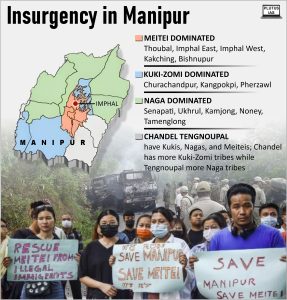01 Dec Insurgency in Manipur
This article covers “Daily Current Affairs” and the topic details “ Insurgency in Manipur”. This topic has relevance in the Social Issues section of the UPSC CSE exam.
GS 2: Social Issues
Why in the news?
Union Home Minister Amit Shah declared the formalization of a peace accord with the Meitei separatist organization, the United National Liberation Front (UNLF), in Manipur. Additionally, he conveyed optimism that this development would serve as a catalyst, inspiring other valley-based insurgent groups (VBIGs) to engage in the peacebuilding process.
Historical Background of Manipur:
- Post the Anglo-Manipur War of 1891, the Kingdom of Manipur was annexed by Britain.
- Manipur became a British protectorate and later joined India in October 1949, achieving separate statehood in 1972.
Rise of Insurgency:
- Manipur’s integration into India resulted in the emergence of insurgent organizations. These groups advocated for an independent state within Manipur’s borders, rejecting the merger with India as involuntary.
- Insurgency issues surfaced in the late 1960s and 1970s, with the founding of the United National Liberation Front (UNLF) in November 1964.
Reasons for Insurgency:
- Merger with India:
- Resentment among Meiteis, the majority community, due to declining influence post-Independence.
- Meitei insurgency initiated in the 1960s against the merger with the Indian Union.
- Ethnic Conflict:
- Diverse ethnic population with Meiteis in the Valley, Nagas in surrounding hills, and Kukis interspersed.
- Overlapping territorial interests and conflicts between Kukis and Nagas, as well as Nagas and Meiteis.
- Demand for Nagalim (Greater Nagaland) includes Naga-inhabited areas of Manipur, while Meiteis seek to preserve historical unity.
- Lack of Socio-economic Development:
-
- Topographical challenges hinder economic development and socio-economic transformation.
- Persistent issues of corruption, mismanagement of funds, and failure to empower common people contribute to dissatisfaction.

Key Highlights of the Manipur Peace Deal
- Peace Agreement Overview:
-
- The specifics of the peace deal have not been publicly disclosed, but experts suggest that it primarily centers around a Suspension of Operations (SoO).
- The SoO entails a mutual agreement between the United National Liberation Front (UNLF) and security forces to refrain from conducting operations against each other.
- Implementation of SoO:
-
- Both the UNLF and security forces commit to not engaging in operations against each other.
- Identified areas within the valley will be designated for building UNLF camps where cadres can stay alongside their arms and ammunition, supervised by the Manipur government and armed forces.
- Talks for a comprehensive peace accord will proceed following the establishment of SoO arrangements.
- About UNLF:
-
- Formed on November 24, 1964, the UNLF is the oldest insurgent group based in the valley.
- Originated with the secession demand from India, led by Arembam Samarendra Singh.
- Initially proscribed and banned under the Unlawful Activities Prevention Act.
- Armed wing, the Manipur People’s Army, established in 1990.
- Two factions currently exist under the chairmanship of Khundongbam Pambei and NC Koireng.
- Area of Operation:
-
- UNLF’s operational areas encompass the valley regions of Manipur and some villages in the Kuki-Zomi hill districts.
- Historically operated from camps and training bases in Myanmar’s Sagaing Region, Chin state, and Rakhine state, with Myanmar military patronage.
- Facing challenges in Myanmar due to attacks against the military junta by Ethnic Armed Organisations (EAOs) and People’s Defence Forces (PDFs).
- Current Status:
-
- One faction of the UNLF faction led by Koireng remains opposed to peace talks.
- The Manipur government withdrew from the Suspension of Operations (SoO) agreement in March 2023.
- Tripartite SoO agreement reached in 2008, involving the Centre, Manipur state, and Kuki-Zomi insurgent groups, aimed at initiating political dialogue.
- Withdrawal attributed to alleged influence on agitation among forest encroachers by the Zomi Revolutionary Army and the Kuki National Army.
Source: The pursuit of peace in troubled Manipur (msn.com)
Download plutus ias current affairs eng med 1st Dec 2023
Q.1 In the context of Manipur’s insurgency, consider the following statements:
- The Meitei insurgency in the 1960s was primarily driven by resentment among the Meiteis due to declining influence post-independence.
- Ongoing clashes between diverse ethnic populations, including Meiteis, Nagas and Kukis, are attributed to overlapping territorial interests and conflicts.
Which of the statements given above is/are correct?
(a) 1 only
(b) 2 only
(c) Both 1 and 2
(d) Neither 1 nor 2
Q.2 The United National Liberation Front (UNLF) is associated with which of the following:
(a) Meitei
(b) Naga
(c) Kukis
(d) Rohingya
Q.3 In the context of insurgency in Manipur, critically analyze the multifaceted factors contributing to the persistent unrest in the region. Discuss the historical background, ethnic complexities, and socio-economic dimensions that have fueled and sustained the insurgency.




No Comments